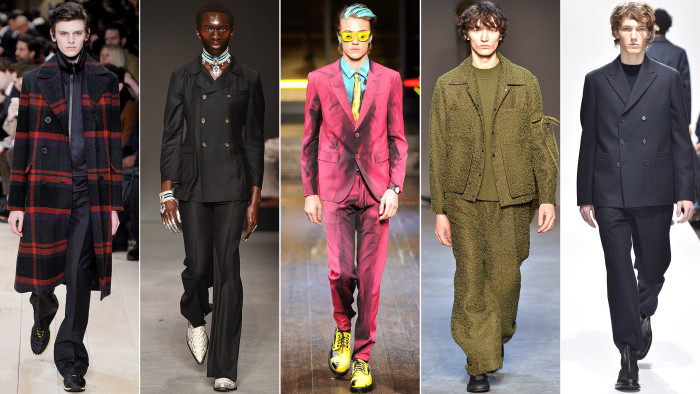London Collections Men AW16 round-up

Simply sign up to the Life & Arts myFT Digest -- delivered directly to your inbox.
Menswear works on seemingly small scales, but in societal terms it can be seismic. The crewneck sweater, for example, or the rollneck. Cardigans. Humdrum. But at London Collections Men, the first leg of the AW16 menswear shows, these knits from tailoring brands are indicative of a major shift in the male wardrobe. Say bye-bye old shirt and tie.
Crewnecks looked sharp under tailoring at Hardy Amies. At Kilgour, it was a turtleneck. Gieves and Hawkes hid shirts and ties under crewnecks like a censor’s bar. “Of course we still have the classic three-piece suit,” said its outgoing creative director Jason Basmajian, “but that’s a given.” In its presentation, Dunhill did show men in broad-chested suits and ties, but things got much more interesting when knits were added in. And yes, that was a sentence including the words “interesting” and “knits”.
It’s the effect of more men making their business away from the typical office environment, of tech industries trumping those of tradition. There are shifts in politics too. During last month’s Spanish elections, it was the informal clothing worn by the young leaders of insurgent parties Podemos and Ciudadanos that pointed to a shattering of the old guard. The codes that dominated the 20th century are losing their grip.
Where ties were present in London, they were often for decorative play. The opening look of Moschino’s clever show was a suit/shirt/tie in vivid shades, printed like a 2D cartoon trying to be 3D. Later, creative director Jeremy Scott used imagery and wording from works by Gilbert & George to create strong, covetable pieces. Scott is an intelligent man who is much maligned for his unblinking love of pop. This collection let him show his depth.
None of these brands would be showing in London if it weren’t for emerging talent. It’s more than 10 years since Lulu Kennedy and Topman staged their first MAN showcase for new designers, triggering the chain of events that led to London Collections Men.
The latest MAN was one of their best, including the show of the week by Grace Wales Bonner. Hers is a specific world, founded on deep research into narratives of black history and culture. Three seasons since graduating, the 25-year-old has already established an elongated silhouette and style vivid enough to win her Emerging Menswear Designer at the recent British Fashion Awards. With this collection, she pushed production and quality of make. Her jewelled tracksuits will not be cheap. Wales Bonner is a designer going for enlightened customer rather than mass production.
Also worth watching from MAN is Charles Jeffrey, who consolidated the chaos of his club night, Loverboy, with assured design skills, particularly in purposefully dishevelled knits and louche tailoring. From the swagger of his models to the state of their dress, it felt like danger was in the room. Vivienne Westwood should be hiring him as creative director immediately.
The pleasure of London menswear is seeing brands evolve at their own pace. Craig Green rendered his workwear jackets in bouclé, as well as quilted jackets in a dusty washed-out green. Christopher Shannon took a break from the catwalk to concentrate on clothing itself, notably shirts of mismatched check and zip-ups of different length fleece. Sibling showed vivid knits of genuine technical accomplishment. Liam Hodges sent out some brilliantly blokeish fashion inspired by car culture, especially a rib sweater and trackpant in number-plate yellow. And it was with the soft jackets of Margaret Howell that tailoring looked the most appropriate.
But take a bit of breathing space after many of the shows and you think, why did they show that? Heavy outerwear was all over the catwalk, especially at two of the biggest brands, Burberry and Coach. The opening look at Coach was an oversized shearling coat of Muppet hair length. First model out at Burberry was in a knee-length double-breasted wool coat. The lumbering format of the old twice-yearly show system looks less and less smart (see Jo Ellison: Can seasons be weatherproofed?). But beneath it all, both brands did show neat climate-appropriate pieces: thinner leather jackets at Coach, some great funnel-neck tracksuits at Burberry.
It was at the presentation of Pieter where clothing had the most city-appropriate snap. His knee-length coat was in fine wool flannel. Sleek black nylon anoraks were worn with tailored pants. Oversized shirts worked as jackets in themselves. Young designer Sebastiaan Pieter’s work was modern — not just the clothes themselves, but in an awareness of the world in which we live in today.
Charlie Porter is the FT men’s fashion critic. Click here for his men’s AW show reports
Return to Style homepage
Comments